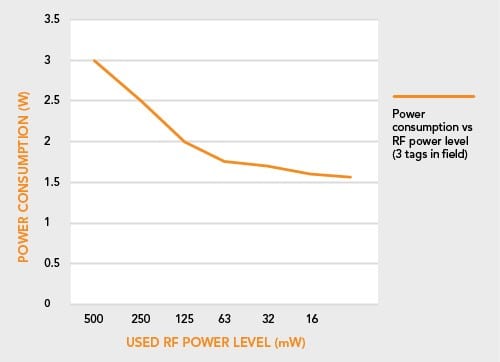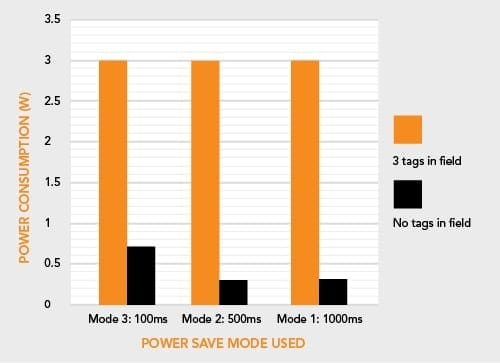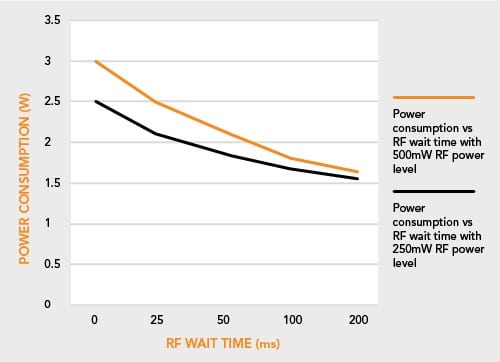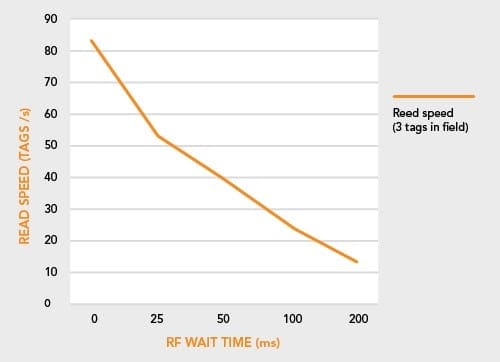how DIFFERENT POWER SAVING OPTIONS AFFECT YOUR RFID READER’S BATTERY LIFE AND POWER CONSUMPTION
ON RFID READER BATTERY LIFE. LESS POWER CONSUMPTION MEANS MORE BATTERY LIFE AND OPERATING TIME FOR BATTERY POWERED READERS
When we talk about battery powered RFID readers, power consumption and operating time are very important parameters. This is especially true for UHF RFID readers, as UHF RFID readers consume relatively large amounts of power when operating at full RF power.
This article covers three different approaches on how to decrease power consumption. These tests were carried out using Nordic ID Stix USB RFID reader.
There are three different approaches for decreasing power consumption of the RFID reader we tested. All three are good ways to save power as long as the right approach is chosen. The first approach is to decrease the actual RF power level in which the reader is operating. The down side to that approach is that you will lose the maximum read range. The second option is to use integrated power save modes. This decreases power consumption when reading is on, but there are no tags in the reader’s field. The third option is to implement the “duty cycle” into the host application or to use the RF-off time parameter inside the firmware in order to apply the duty cycle functionality. Note that these three approaches can be used simultaneously. We shall now look further into these options one by one.
- REDUCING THE RF POWER LEVEL
Reducing the RF power level is a very straight forward way to reduce the power consumption. Nevertheless, it will mean that the reader is not working at maximum read range. This is not always an efficient way to decrease power consumption, because as you cut the RF power to half, the power consumption is not decreased by half. It will not be even close to that. This is because the RF power amplifiers are usually tuned to provide maximum efficiency when the maximum output power is used and the efficiency drops greatly with lower RF power levels.
Figure 1 shows the average power consumption with different RF power levels. Note that the test was carried out with tags in the reader’s field, to ensure that RF test results are not impacted by the reader’s power save mode (see next section for definition). The graph illustrates that when the RF power level is set to the minimum value, the power consumption has dropped to half.
Advantage
- Easy way to save power if read range is not an issue
Disadvantage
- Not an efficient way to gain power savings

-
POWER SAVE MODES
In our test the battery operated RFID reader has integrated power save modes, which can be used as a power saving option. The power save mode operates in a way that when there are no tags in the reader’s field, the reading is stopped for the selected time period. Our test device has three different period length options available. The shortest period is 100ms, the second option is 500ms and the longest is 1000ms. Immediately when a tag enters the reader’s field, the reading is switched back on and continues without any breaks.
Using this method, the reading performance is not decreased at all. Nevertheless, this will obviously save power only in situations, where there are no tags in the reader’s field.
Figure 2 illustrates the measured power consumption with the three different period length options. It is apparent that the power consumption is not decreased when tag(s) are in the reader’s field. Once there are no tags in reading range, the power consumption is decreased enormously. This will have a big effect on battery life in cases where reading is ON most of the time but there are no tags in the reader’s reading range. Some possible use cases might be access control applications.
Advantages
- Very efficient way to reduce power consumption without reducing the read range
- No effect to read performance
Disadvantage
- Saves power only when there is no tag(s) in the reader’s field

-
APPLYING THE DUTY CYCLE
For the reader these tests were carried out with, there are two different approaches to applying duty cycles. The first one is to apply duty cycles in the application layer. In practice this means that the host application will have off times between separate reads. The other and more efficient way is to use an RF off time parameter. We selected the RF off time parameter approach for duty cycle testing.
What the RF off time parameter does, is that it will turn off the transmission and power down the RF power amplifier for the selected time period. This will decrease the average power consumption regardless of whether there are tags in the reader’s field or not. It does not affect the maximum read distance but will lower the read speed of the reader. Nevertheless, in many cases the lower read speed should not pose a problem. Figure 3 illustrates measured power consumptions with different RF off time parameters and with two RF power levels. This test was carried out with tags in the reader’s field, to ensure that duty cycle results are not impacted by the device’s power save mode.
Advantage
- Decreases the power consumption without decreasing the maximum read range although there are tags in the reader’s field.
Disadvantage
- The read speed is decreased

The figure below shows the effect of RF off time parameters on reading speed. Reduced read speed is in many cases not an issue.

Want to also understand how to apply RSSI filters for optimal RFID performance? Read our expert article.